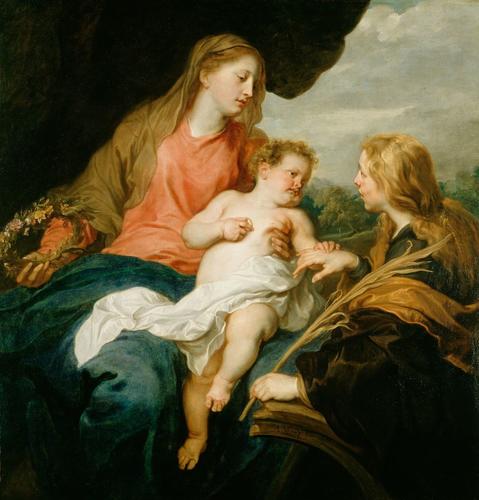The Mystic Marriage of St Catherine c. 1630
Oil on canvas | 126.2 x 119.5 cm (support, canvas/panel/stretcher external) | RCIN 405332
-
Van Dyck first went to Italy in 1621 in the company of the Countess of Arundel; while in Venice it is possible that the party was shown around the city by Tizianello, the son of Titian’s cousin and assistant, Marco Vecellio. Whether or not this special privilege was necessary, Van Dyck’s Italian journey seems to have been dominated by his discovery of Titian (c.1487-1576), an artist whose works are constantly mentioned in the drawings and notes he made during his trip (the so-called Italian Sketch-book now resides in the British Museum). According to Joachim von Sandrart (1606-88), he avoided academies in Rome studying Raphael and the antique, nor does he seem to have been any more interested in his Italian contemporaries; if anything, he influenced their work rather than vice versa.
The influence of Titian can been seen in a comparison between Christ Healing the Paralytic (Royal Collection) and this painting, one executed soon before and the other soon after his Italian sojourn. Both paintings show three principal figures ranged across the canvas, moving step-wise into depth. But in contrast to the robust sculptural forms of the Healing, this later composition is dominated by a pattern of shapes on the surface, a map of seas and continents fitting neatly together. The important colours - the blue, red and white of the Virgin - saturate entire zones. The use of pure colour and the arrangement of forms diagonally across the front plane in a ‘soft’ perspective derived from Titian and may be clearly seen in Teniers’s reduced copies of The Virgin and Child and The Virgin and Child with Sts Stephen, Jerome and Maurice also in the Royal Collection.
St Catherine of Alexandria was contemplating an image of the Virgin, when the Christ Child seemed to come to life and offer her a ring as a symbol of their mystical betrothal. We must imagine here that the same episode is occurring ‘in reality’ in heaven, after she has been martyred, which is why she holds a martyr’s palm and rests upon the broken wheel, with which the Emperor Maxentius tried unsuccessfully to tear her to pieces. The appearance of the Virgin’s glowing white face and straight-nosed profile derive from the translucent stone of an antique cameo. St Catherine was a princess and no paralytic; however, her unbound hair (an unthinkable style at this date) speaks of the ordeal she has just suffered. The deformation of the breast of the Christ Child is a deliberate reference to the ‘milk of human kindness’ and accompanies his sympathetic expression. This composition is repeated, with an elderly couple instead of St Catherine, in Van Dyck’s Virgin and Child with Two Donors (Louvre), also of c.1630.
Catalogue entry adapted from Bruegel to Rubens: Masters of Flemish Painting, London, 2007Provenance
Acquired by George IV in 1821 for 2000 guineas; added to the Carlton House inventory dated 1816 (no 587) and 1819 (no 582); in the Picture Gallery in Buckingham Palace in 1841 (no 169)
-
Creator(s)
Acquirer(s)
-
Medium and techniques
Oil on canvas
Measurements
126.2 x 119.5 cm (support, canvas/panel/stretcher external)
151.3 x 144.7 x 9.3 cm (frame, external)








